Analysing Management and Organisations in a Global Environment
VerifiedAdded on 2023/06/09
|6
|1459
|467
Essay
AI Summary
This essay provides an overview of management and organisations in a global environment, focusing on organizational structures and decision-making processes. It discusses the impact of organizational structure on management decisions, highlighting the importance of considering internal and external environments. The essay explores holacracy as a futuristic organizational design and examines the Milgram and Asch experiments to understand obedience and conformity in decision-making. It emphasizes the need for independent thinking and sensitivity towards stakeholders in organizational decision-making. The document is available on Desklib, a platform offering a range of study resources for students.
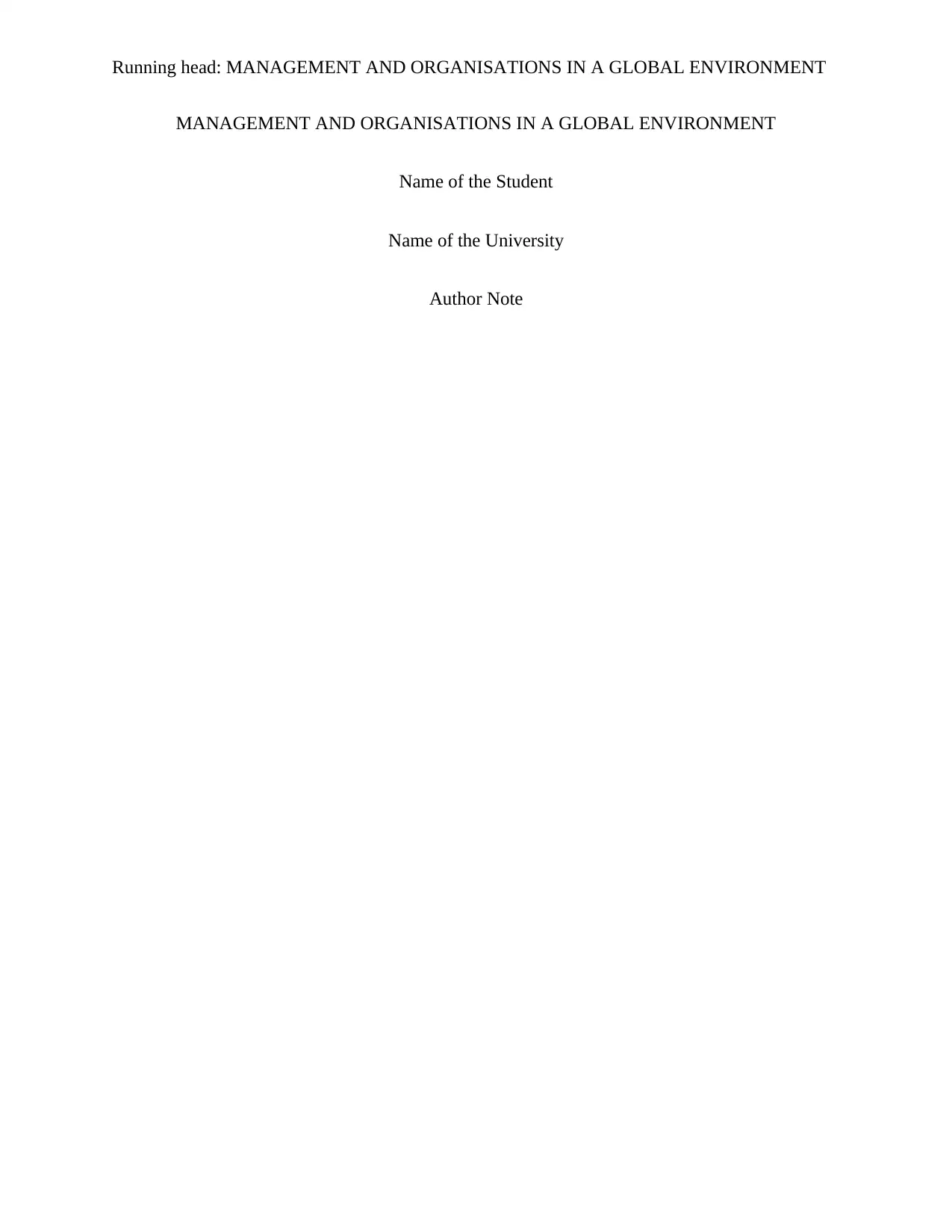
Running head: MANAGEMENT AND ORGANISATIONS IN A GLOBAL ENVIRONMENT
MANAGEMENT AND ORGANISATIONS IN A GLOBAL ENVIRONMENT
Name of the Student
Name of the University
Author Note
MANAGEMENT AND ORGANISATIONS IN A GLOBAL ENVIRONMENT
Name of the Student
Name of the University
Author Note
Paraphrase This Document
Need a fresh take? Get an instant paraphrase of this document with our AI Paraphraser
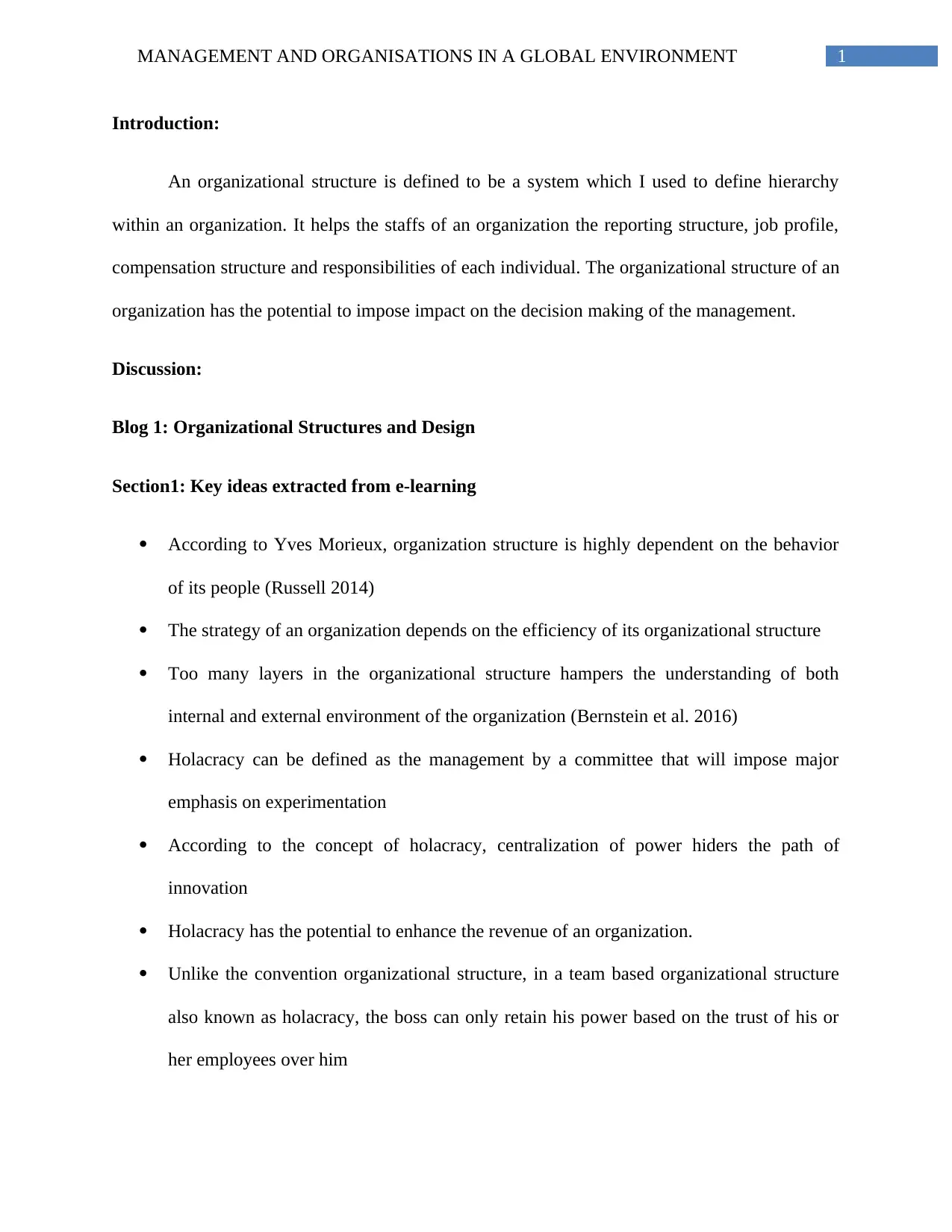
1MANAGEMENT AND ORGANISATIONS IN A GLOBAL ENVIRONMENT
Introduction:
An organizational structure is defined to be a system which I used to define hierarchy
within an organization. It helps the staffs of an organization the reporting structure, job profile,
compensation structure and responsibilities of each individual. The organizational structure of an
organization has the potential to impose impact on the decision making of the management.
Discussion:
Blog 1: Organizational Structures and Design
Section1: Key ideas extracted from e-learning
According to Yves Morieux, organization structure is highly dependent on the behavior
of its people (Russell 2014)
The strategy of an organization depends on the efficiency of its organizational structure
Too many layers in the organizational structure hampers the understanding of both
internal and external environment of the organization (Bernstein et al. 2016)
Holacracy can be defined as the management by a committee that will impose major
emphasis on experimentation
According to the concept of holacracy, centralization of power hiders the path of
innovation
Holacracy has the potential to enhance the revenue of an organization.
Unlike the convention organizational structure, in a team based organizational structure
also known as holacracy, the boss can only retain his power based on the trust of his or
her employees over him
Introduction:
An organizational structure is defined to be a system which I used to define hierarchy
within an organization. It helps the staffs of an organization the reporting structure, job profile,
compensation structure and responsibilities of each individual. The organizational structure of an
organization has the potential to impose impact on the decision making of the management.
Discussion:
Blog 1: Organizational Structures and Design
Section1: Key ideas extracted from e-learning
According to Yves Morieux, organization structure is highly dependent on the behavior
of its people (Russell 2014)
The strategy of an organization depends on the efficiency of its organizational structure
Too many layers in the organizational structure hampers the understanding of both
internal and external environment of the organization (Bernstein et al. 2016)
Holacracy can be defined as the management by a committee that will impose major
emphasis on experimentation
According to the concept of holacracy, centralization of power hiders the path of
innovation
Holacracy has the potential to enhance the revenue of an organization.
Unlike the convention organizational structure, in a team based organizational structure
also known as holacracy, the boss can only retain his power based on the trust of his or
her employees over him
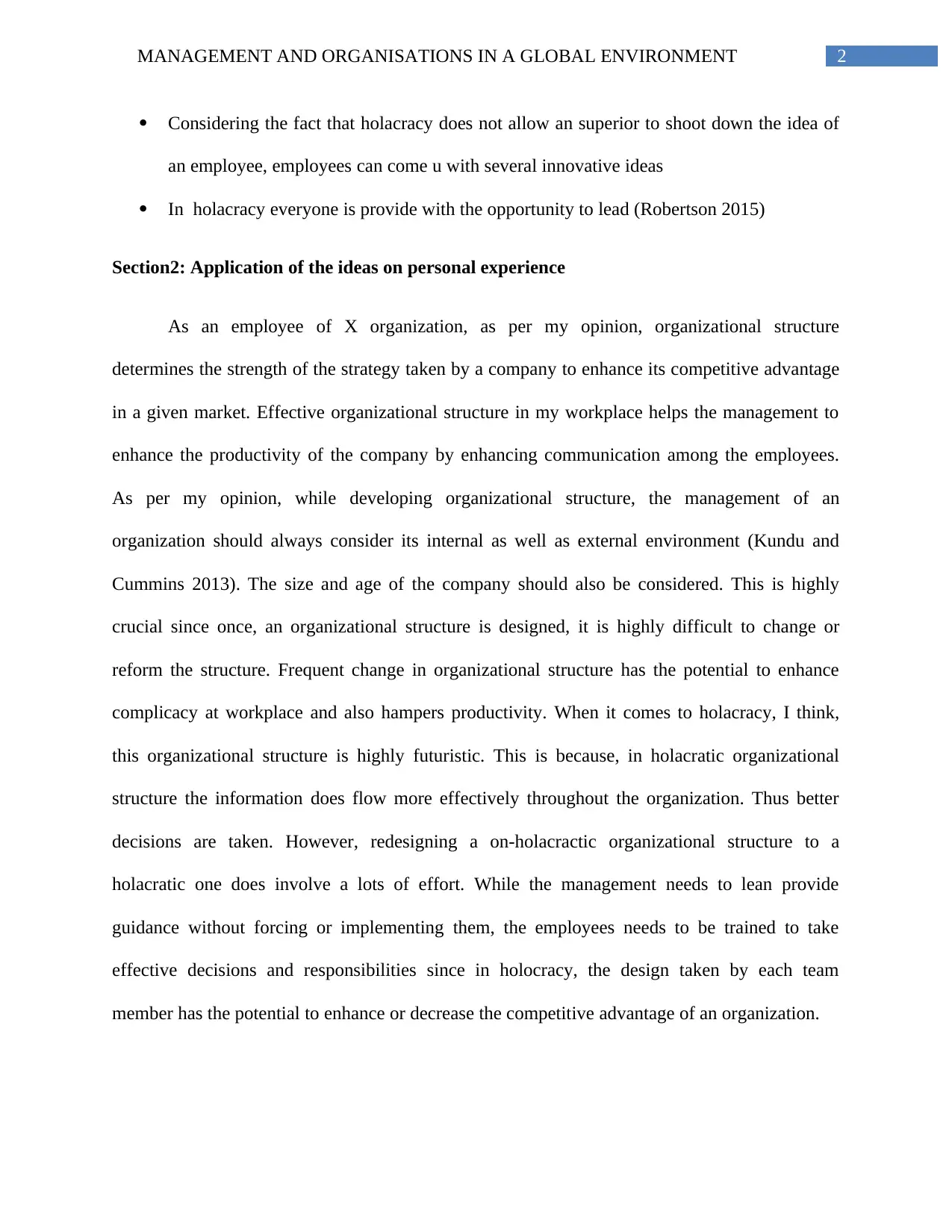
2MANAGEMENT AND ORGANISATIONS IN A GLOBAL ENVIRONMENT
Considering the fact that holacracy does not allow an superior to shoot down the idea of
an employee, employees can come u with several innovative ideas
In holacracy everyone is provide with the opportunity to lead (Robertson 2015)
Section2: Application of the ideas on personal experience
As an employee of X organization, as per my opinion, organizational structure
determines the strength of the strategy taken by a company to enhance its competitive advantage
in a given market. Effective organizational structure in my workplace helps the management to
enhance the productivity of the company by enhancing communication among the employees.
As per my opinion, while developing organizational structure, the management of an
organization should always consider its internal as well as external environment (Kundu and
Cummins 2013). The size and age of the company should also be considered. This is highly
crucial since once, an organizational structure is designed, it is highly difficult to change or
reform the structure. Frequent change in organizational structure has the potential to enhance
complicacy at workplace and also hampers productivity. When it comes to holacracy, I think,
this organizational structure is highly futuristic. This is because, in holacratic organizational
structure the information does flow more effectively throughout the organization. Thus better
decisions are taken. However, redesigning a on-holacractic organizational structure to a
holacratic one does involve a lots of effort. While the management needs to lean provide
guidance without forcing or implementing them, the employees needs to be trained to take
effective decisions and responsibilities since in holocracy, the design taken by each team
member has the potential to enhance or decrease the competitive advantage of an organization.
Considering the fact that holacracy does not allow an superior to shoot down the idea of
an employee, employees can come u with several innovative ideas
In holacracy everyone is provide with the opportunity to lead (Robertson 2015)
Section2: Application of the ideas on personal experience
As an employee of X organization, as per my opinion, organizational structure
determines the strength of the strategy taken by a company to enhance its competitive advantage
in a given market. Effective organizational structure in my workplace helps the management to
enhance the productivity of the company by enhancing communication among the employees.
As per my opinion, while developing organizational structure, the management of an
organization should always consider its internal as well as external environment (Kundu and
Cummins 2013). The size and age of the company should also be considered. This is highly
crucial since once, an organizational structure is designed, it is highly difficult to change or
reform the structure. Frequent change in organizational structure has the potential to enhance
complicacy at workplace and also hampers productivity. When it comes to holacracy, I think,
this organizational structure is highly futuristic. This is because, in holacratic organizational
structure the information does flow more effectively throughout the organization. Thus better
decisions are taken. However, redesigning a on-holacractic organizational structure to a
holacratic one does involve a lots of effort. While the management needs to lean provide
guidance without forcing or implementing them, the employees needs to be trained to take
effective decisions and responsibilities since in holocracy, the design taken by each team
member has the potential to enhance or decrease the competitive advantage of an organization.
⊘ This is a preview!⊘
Do you want full access?
Subscribe today to unlock all pages.

Trusted by 1+ million students worldwide
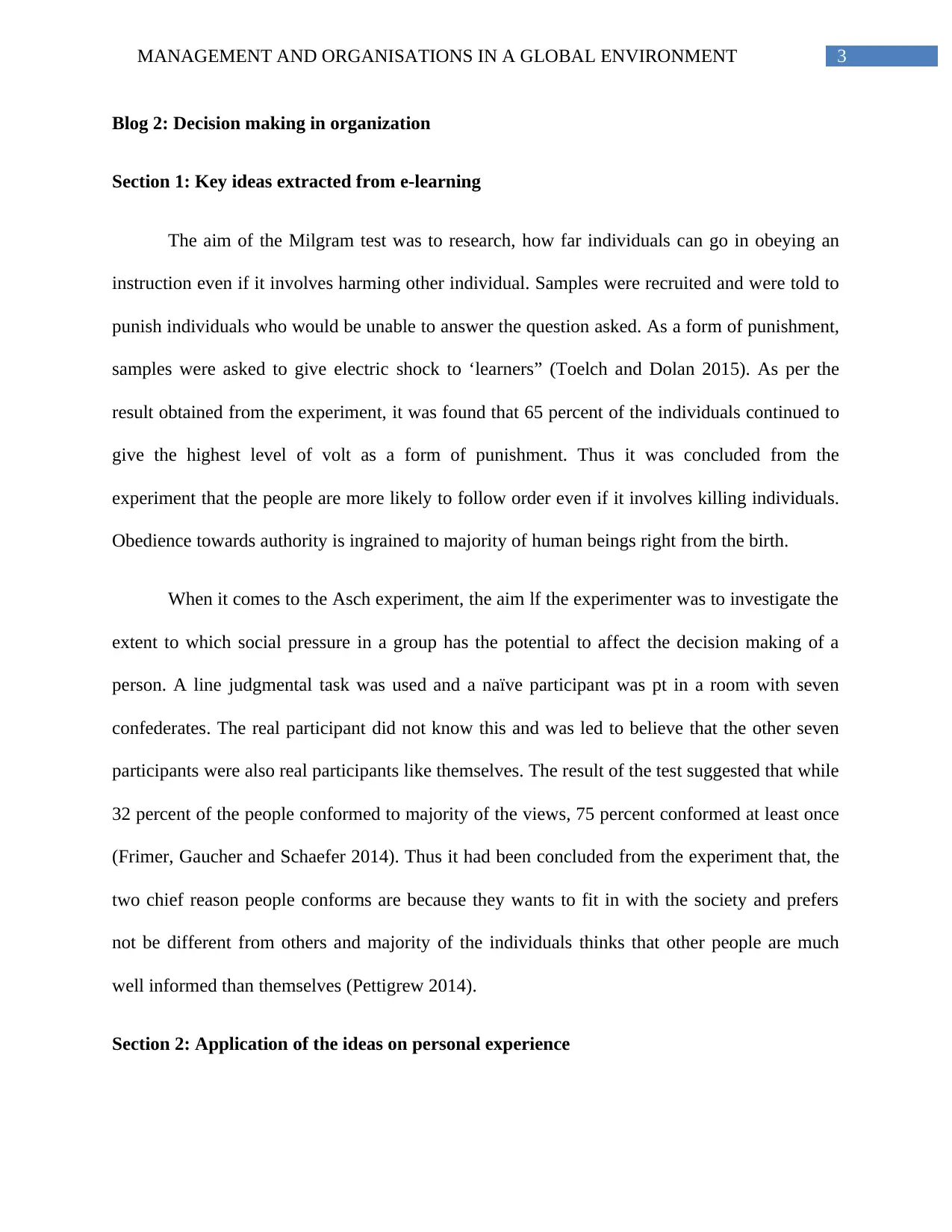
3MANAGEMENT AND ORGANISATIONS IN A GLOBAL ENVIRONMENT
Blog 2: Decision making in organization
Section 1: Key ideas extracted from e-learning
The aim of the Milgram test was to research, how far individuals can go in obeying an
instruction even if it involves harming other individual. Samples were recruited and were told to
punish individuals who would be unable to answer the question asked. As a form of punishment,
samples were asked to give electric shock to ‘learners” (Toelch and Dolan 2015). As per the
result obtained from the experiment, it was found that 65 percent of the individuals continued to
give the highest level of volt as a form of punishment. Thus it was concluded from the
experiment that the people are more likely to follow order even if it involves killing individuals.
Obedience towards authority is ingrained to majority of human beings right from the birth.
When it comes to the Asch experiment, the aim lf the experimenter was to investigate the
extent to which social pressure in a group has the potential to affect the decision making of a
person. A line judgmental task was used and a naïve participant was pt in a room with seven
confederates. The real participant did not know this and was led to believe that the other seven
participants were also real participants like themselves. The result of the test suggested that while
32 percent of the people conformed to majority of the views, 75 percent conformed at least once
(Frimer, Gaucher and Schaefer 2014). Thus it had been concluded from the experiment that, the
two chief reason people conforms are because they wants to fit in with the society and prefers
not be different from others and majority of the individuals thinks that other people are much
well informed than themselves (Pettigrew 2014).
Section 2: Application of the ideas on personal experience
Blog 2: Decision making in organization
Section 1: Key ideas extracted from e-learning
The aim of the Milgram test was to research, how far individuals can go in obeying an
instruction even if it involves harming other individual. Samples were recruited and were told to
punish individuals who would be unable to answer the question asked. As a form of punishment,
samples were asked to give electric shock to ‘learners” (Toelch and Dolan 2015). As per the
result obtained from the experiment, it was found that 65 percent of the individuals continued to
give the highest level of volt as a form of punishment. Thus it was concluded from the
experiment that the people are more likely to follow order even if it involves killing individuals.
Obedience towards authority is ingrained to majority of human beings right from the birth.
When it comes to the Asch experiment, the aim lf the experimenter was to investigate the
extent to which social pressure in a group has the potential to affect the decision making of a
person. A line judgmental task was used and a naïve participant was pt in a room with seven
confederates. The real participant did not know this and was led to believe that the other seven
participants were also real participants like themselves. The result of the test suggested that while
32 percent of the people conformed to majority of the views, 75 percent conformed at least once
(Frimer, Gaucher and Schaefer 2014). Thus it had been concluded from the experiment that, the
two chief reason people conforms are because they wants to fit in with the society and prefers
not be different from others and majority of the individuals thinks that other people are much
well informed than themselves (Pettigrew 2014).
Section 2: Application of the ideas on personal experience
Paraphrase This Document
Need a fresh take? Get an instant paraphrase of this document with our AI Paraphraser
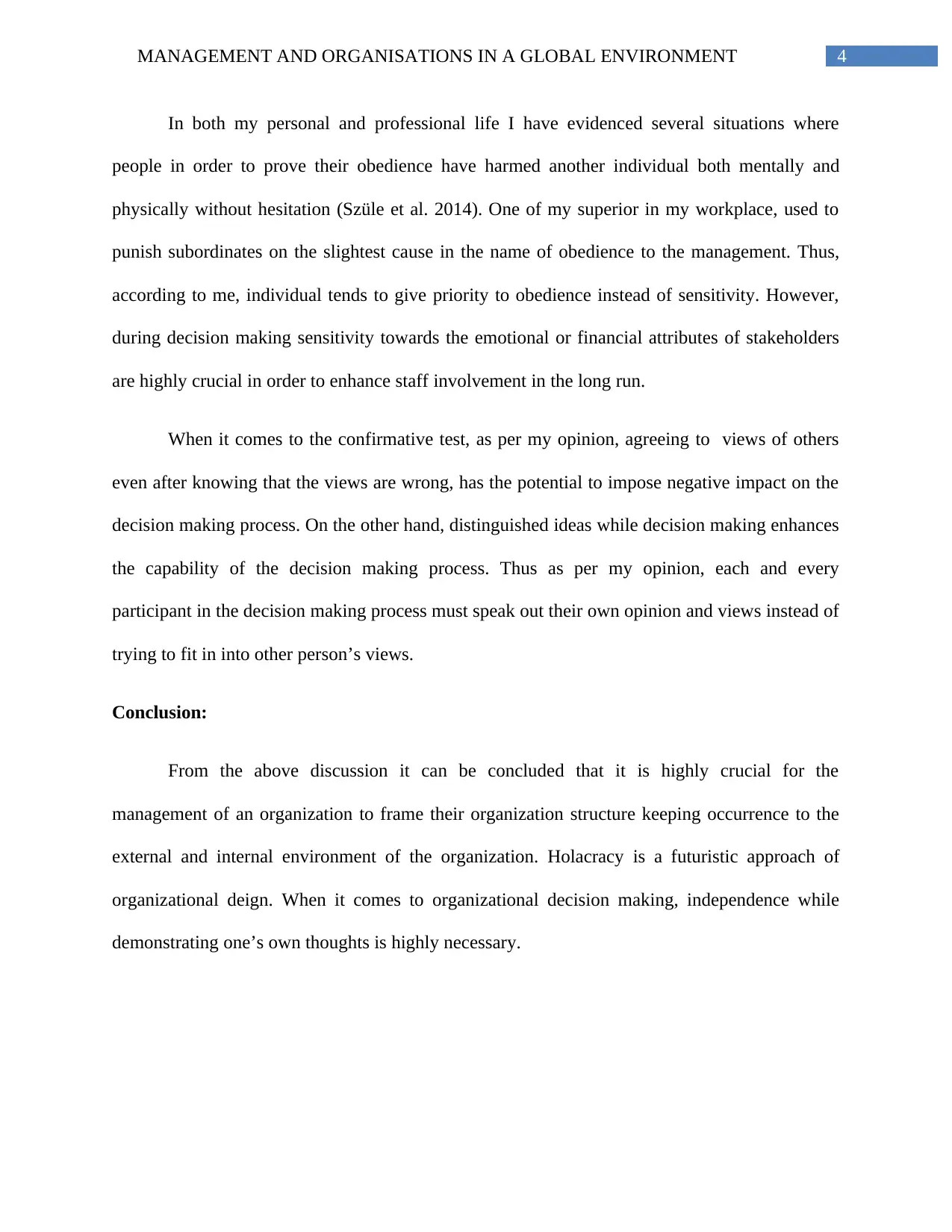
4MANAGEMENT AND ORGANISATIONS IN A GLOBAL ENVIRONMENT
In both my personal and professional life I have evidenced several situations where
people in order to prove their obedience have harmed another individual both mentally and
physically without hesitation (Szüle et al. 2014). One of my superior in my workplace, used to
punish subordinates on the slightest cause in the name of obedience to the management. Thus,
according to me, individual tends to give priority to obedience instead of sensitivity. However,
during decision making sensitivity towards the emotional or financial attributes of stakeholders
are highly crucial in order to enhance staff involvement in the long run.
When it comes to the confirmative test, as per my opinion, agreeing to views of others
even after knowing that the views are wrong, has the potential to impose negative impact on the
decision making process. On the other hand, distinguished ideas while decision making enhances
the capability of the decision making process. Thus as per my opinion, each and every
participant in the decision making process must speak out their own opinion and views instead of
trying to fit in into other person’s views.
Conclusion:
From the above discussion it can be concluded that it is highly crucial for the
management of an organization to frame their organization structure keeping occurrence to the
external and internal environment of the organization. Holacracy is a futuristic approach of
organizational deign. When it comes to organizational decision making, independence while
demonstrating one’s own thoughts is highly necessary.
In both my personal and professional life I have evidenced several situations where
people in order to prove their obedience have harmed another individual both mentally and
physically without hesitation (Szüle et al. 2014). One of my superior in my workplace, used to
punish subordinates on the slightest cause in the name of obedience to the management. Thus,
according to me, individual tends to give priority to obedience instead of sensitivity. However,
during decision making sensitivity towards the emotional or financial attributes of stakeholders
are highly crucial in order to enhance staff involvement in the long run.
When it comes to the confirmative test, as per my opinion, agreeing to views of others
even after knowing that the views are wrong, has the potential to impose negative impact on the
decision making process. On the other hand, distinguished ideas while decision making enhances
the capability of the decision making process. Thus as per my opinion, each and every
participant in the decision making process must speak out their own opinion and views instead of
trying to fit in into other person’s views.
Conclusion:
From the above discussion it can be concluded that it is highly crucial for the
management of an organization to frame their organization structure keeping occurrence to the
external and internal environment of the organization. Holacracy is a futuristic approach of
organizational deign. When it comes to organizational decision making, independence while
demonstrating one’s own thoughts is highly necessary.
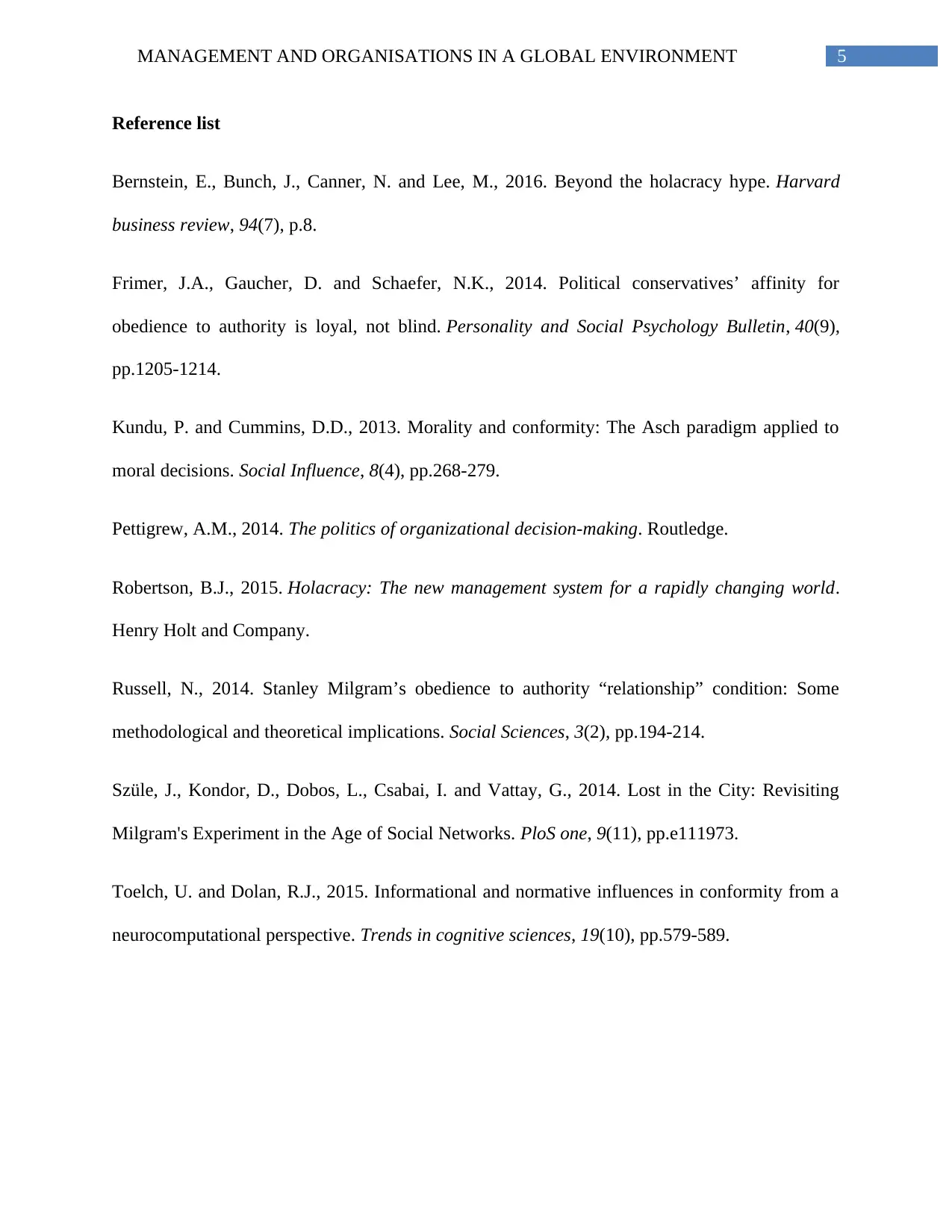
5MANAGEMENT AND ORGANISATIONS IN A GLOBAL ENVIRONMENT
Reference list
Bernstein, E., Bunch, J., Canner, N. and Lee, M., 2016. Beyond the holacracy hype. Harvard
business review, 94(7), p.8.
Frimer, J.A., Gaucher, D. and Schaefer, N.K., 2014. Political conservatives’ affinity for
obedience to authority is loyal, not blind. Personality and Social Psychology Bulletin, 40(9),
pp.1205-1214.
Kundu, P. and Cummins, D.D., 2013. Morality and conformity: The Asch paradigm applied to
moral decisions. Social Influence, 8(4), pp.268-279.
Pettigrew, A.M., 2014. The politics of organizational decision-making. Routledge.
Robertson, B.J., 2015. Holacracy: The new management system for a rapidly changing world.
Henry Holt and Company.
Russell, N., 2014. Stanley Milgram’s obedience to authority “relationship” condition: Some
methodological and theoretical implications. Social Sciences, 3(2), pp.194-214.
Szüle, J., Kondor, D., Dobos, L., Csabai, I. and Vattay, G., 2014. Lost in the City: Revisiting
Milgram's Experiment in the Age of Social Networks. PloS one, 9(11), pp.e111973.
Toelch, U. and Dolan, R.J., 2015. Informational and normative influences in conformity from a
neurocomputational perspective. Trends in cognitive sciences, 19(10), pp.579-589.
Reference list
Bernstein, E., Bunch, J., Canner, N. and Lee, M., 2016. Beyond the holacracy hype. Harvard
business review, 94(7), p.8.
Frimer, J.A., Gaucher, D. and Schaefer, N.K., 2014. Political conservatives’ affinity for
obedience to authority is loyal, not blind. Personality and Social Psychology Bulletin, 40(9),
pp.1205-1214.
Kundu, P. and Cummins, D.D., 2013. Morality and conformity: The Asch paradigm applied to
moral decisions. Social Influence, 8(4), pp.268-279.
Pettigrew, A.M., 2014. The politics of organizational decision-making. Routledge.
Robertson, B.J., 2015. Holacracy: The new management system for a rapidly changing world.
Henry Holt and Company.
Russell, N., 2014. Stanley Milgram’s obedience to authority “relationship” condition: Some
methodological and theoretical implications. Social Sciences, 3(2), pp.194-214.
Szüle, J., Kondor, D., Dobos, L., Csabai, I. and Vattay, G., 2014. Lost in the City: Revisiting
Milgram's Experiment in the Age of Social Networks. PloS one, 9(11), pp.e111973.
Toelch, U. and Dolan, R.J., 2015. Informational and normative influences in conformity from a
neurocomputational perspective. Trends in cognitive sciences, 19(10), pp.579-589.
⊘ This is a preview!⊘
Do you want full access?
Subscribe today to unlock all pages.

Trusted by 1+ million students worldwide
1 out of 6
Related Documents
Your All-in-One AI-Powered Toolkit for Academic Success.
+13062052269
info@desklib.com
Available 24*7 on WhatsApp / Email
![[object Object]](/_next/static/media/star-bottom.7253800d.svg)
Unlock your academic potential
Copyright © 2020–2025 A2Z Services. All Rights Reserved. Developed and managed by ZUCOL.





